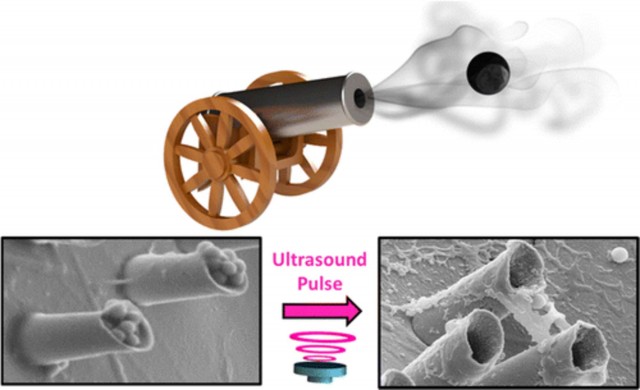Scientists have been trying to replace hypodermic needles with jet injectors since the 1960s, but have yet to come with complete success. Jet injectors were created to replace needles and limit disease transmission between patients, but like most devices that break the skin, they were vulnerable to becoming a virus vector.

But now, nanoengineers from the University of San Diego have built an acoustic microcannon, a device powered by ultrasound that is a completely needle-free drug delivery method aimed to get medicine straight to the deep tissue where it’s needed to do work.
Several companies don’t recommend using jet injectors as they can transmit disease between patients, especially heptatitis B as it’s small enough to be picked up by cross-contamination on the unnoticeable order of nanoliters. Jet injectors can also immunize the patient with environmental pathogens and skin flora during the vaccination. A clinic using jet injectors to apply lidocaine also vaccinated multiple patients with bacteria called Mycobacterium chelonae sp. Abscessus that has been growing in distilled water.
Quite frankly, there needs to be a better solution, which is where UCSD scientists began. The microcannon starts with a membranous polymer film, where the nanoengineers poked holes through its elastic membrane and spray-coated it with layers of graphene and gold to make the cannon barrels rigid. From there, they backed the membrane with a gel matrix that contained perfluorocarbon (PFC) propellant and luminous nanobullets approximately a micron wide and then hit it with ultrasound. As PFC vaporizes when hit with an ultrasound pulse, it produces expanding bubbles that fire the nanobullets out of the microcannons at rapid speeds. The bright microbullets illuminate to show exactly where they landed in the tissue.
“This acoustic-microcannon approach could be translated into advanced microscale ballistic tools, capable of efficient loading and firing of multiple cargoes, and offer improved accessibility to target locations and enhanced tissue penetration properties,” the researchers noted.
Ultrasound is a more efficient way to deliver drugs than gas tanks, and directly targeting medication to tissue could be more effective than digestion, which forces medicine through the hepatic portal (part of the body’s filter system). An ultrasound device can even be handheld, as we see with a hypospray.
While there’s no confirmation when this device will be available to all patients, nanoengineers from UCSD are working to develop the tool further.
Source: ExtremeTech
Advertisement
Learn more about Electronic Products Magazine





